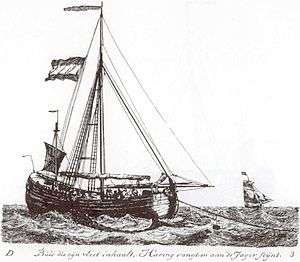Herring as food
Herring are forage fish in the wild, mostly belonging to the family Clupeidae, but they are also an important food for humans. Herring often move in large schools around fishing banks and near the coast. The most abundant and commercially important species belong to the genus Clupea, found particularly in shallow, temperate waters of the North Pacific and North Atlantic Oceans, including the Baltic Sea, as well as off the west coast of South America. Three species of Clupea are recognized; the main taxon, the Atlantic herring, accounts for over half the world's commercial capture of herrings.
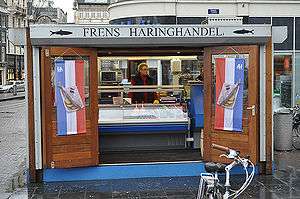
Herrings played a pivotal role in the history of marine fisheries in Europe,[1] and early in the twentieth century, their study was fundamental to the evolution of fisheries science.[2][3] These oily fish[4] also have a long history as an important food fish, and are often salted, smoked, or pickled.
Nutrition
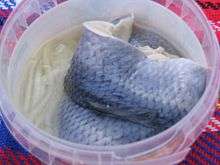 | |
| Nutritional value per 100 g (3.5 oz) | |
|---|---|
| Energy | 661 kJ (158 kcal) |
0.0 g | |
| Sugars | 0.00 |
| Dietary fiber | 0.0 g |
9.04 g | |
17.96 g | |
| Vitamins | Quantity %DV† |
| Thiamine (B1) | 8% 0.092 mg |
| Riboflavin (B2) | 19% 0.233 mg |
| Niacin (B3) | 21% 3.217 mg |
| Pantothenic acid (B5) | 13% 0.645 mg |
| Vitamin B6 | 23% 0.302 mg |
| Folate (B9) | 3% 10 μg |
| Vitamin B12 | 570% 13.67 μg |
| Vitamin C | 1% 0.7 mg |
| Vitamin D | 28% 167 IU |
| Vitamin E | 7% 1.07 mg |
| Minerals | Quantity %DV† |
| Calcium | 6% 57 mg |
| Iron | 8% 1.10 mg |
| Magnesium | 9% 32 mg |
| Manganese | 2% 0.035 mg |
| Phosphorus | 34% 236 mg |
| Potassium | 7% 327 mg |
| Sodium | 6% 90 mg |
| Zinc | 10% 0.99 mg |
| Other constituents | Quantity |
| Water | 72 g |
| |
| †Percentages are roughly approximated using US recommendations for adults. | |
Raw Atlantic herring is 72% water, 18% protein, 9% fat, and contains no carbohydrates. In a 100 gram reference amount, raw herring provides 158 calories, and is a highly rich source (20% or more of the Daily Value, DV) of vitamin B12 (570% DV). It also has rich content of niacin, vitamin B6, vitamin D, and phosphorus (21-34% DV). Raw herring contains moderate amounts of other B vitamins and zinc, and is an excellent food source of omega-3 fatty acids.[5]
Preparation
Herring has been a staple food source since at least 3000 B.C. There are numerous ways the fish is served and many regional recipes: eaten raw, fermented, pickled, or cured by other techniques.
Raw
A typical Dutch delicacy is Hollandse Nieuwe (Dutch New), which is raw herring from the catches around the end of spring and the beginning of summer. This is typically eaten with raw onion. Hollandse nieuwe is only available in spring when the first seasonal catch of herring is brought in. This is celebrated in festivals such as the Vlaardingen Herring Festival and Vlaggetjesdag in Scheveningen. The new herring are frozen and enzyme-preserved for the remainder of the year. The herring is said to be eaten "raw" because it has not been cooked, although it has been subjected to a degree of curing. The first barrel of Hollandse Nieuwe is traditionally sold at auction for charity. Very young herring are called whitebait and are eaten whole as a delicacy.
Fermented
In Sweden, Baltic herring ("Strömming") is fermented to make surströmming.
Pickled
Pickled herrings are part of Scandinavian, Nordic, Dutch, German (Bismarckhering), Polish, Baltic, Eastern Slavic and Jewish[10] cuisine. Most cured herrings uses a two-step process. Initially, the herrings are cured with salt to extract water. The second stage involves removing the salt and adding flavorings, typically a vinegar, salt, sugar solution to which ingredients like peppercorn, bay leaves and raw onions are added. Other flavors can be added, such as sherry, mustard and dill. The tradition is strong in Scandinavia, The Netherlands, Iceland and Germany.
Dried
In the Philippines, dried herring is popularly eaten during breakfast, along with garlic rice and eggs.
Smoked
A kipper is a split, gutted and cold smoked herring, a bloater is a whole gutted and cold smoked herring and a buckling is a whole herring, gutted apart from roe or milt and then hot smoked. All are staples of British cuisine. According to George Orwell in The Road to Wigan Pier, the Emperor Charles V erected a statue to the inventor of bloaters.
Smoked herring is a traditional meal on the Danish island in the Baltic Sea, Bornholm. This is also the case in Sweden where one can get hard fried/smoked "Strömming" named "Sotare" in places like Skansen, Stockholm.
Other
In Scotland, herrings are traditionally filleted, coated in seasoned pin-head oatmeal, and fried in a pan with butter or oil. This dish is usually served with "crushed", buttered, and boiled potatoes.
In Sweden, herring soup is a traditional dish.
In Southeast Alaska, western hemlock boughs are cut and placed in the ocean before the herring arrive to spawn. The fertilized herring eggs stick to the boughs, and are easily collected. After being boiled briefly the eggs are removed from the bough. Herring eggs collected in this way are eaten plain or in herring egg salad. This method of collection is part of Tlingit tradition.
Foods and dishes
| Name | Image | Origin | Description |
|---|---|---|---|
| Avruga caviar | 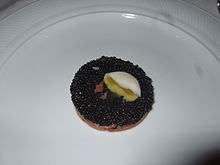 |
Spain | Avruga is marketed by the Spanish company Pescaviar as a caviar substitute. It is made from herring (40%), salt, corn starch, lemon juice, citric acid, xanthan gum, sodium benzoate, squid ink and water. Unlike caviar, it does not contain fish roe.[11] |
| Bloater | 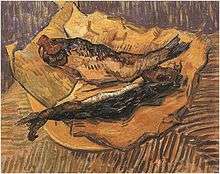 |
England | Popular in the 19th and early 20th centuries, bloaters are now rare. They can be contrasted with kippers. Kippers are salted and cold smoked overnight while bloaters are salted less and not smoked for so long. Kippers are split and gutted before smoking while bloaters are smoked whole without gutting. Kippers are associated with Scotland while bloaters are associated with England. Bloaters have their own characteristic slightly gamey flavor and are called "bloaters" because they swell or bloat during preparation.[12][13][14][15][16] |
| Brathering | 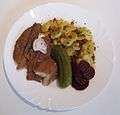 |
Germany | A dish of fried marinated herring. A common recipe starts with fresh herrings with the head and gut removed that are breaded or turned in flour, fried and then pickled in a marinade of vinegar. The pickled herrings are then boiled briefly in water containing onion, salt, spices like pepper, bay leaves, mustard seeds, and a little sugar. The herring are served cold with bread and fried or jacket potatoes].[17] |
| Buckling | 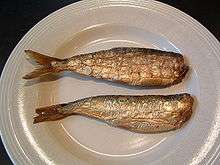 |
European | A hot-smoked herring similar to a kipper or bloater. The guts are removed but the roe or milt remain. Buckling is hot-smoked whole, as opposed to kippers which are split and gutted, and then cold smoked. Bucklings can be eaten hot or cold.[18][19] |
| Dressed herring | 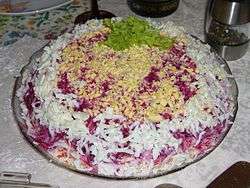 |
Russia | A layered salad of diced salted herring covered with alternating layers of grated boiled vegetables (potato, carrot and beet root) and chopped onions. Optionally includes a layer of fresh grated apple. The final layer is beet root covered with mayonnaise, which gives the salad a rich purple color. Often decorated with grated boiled eggs. Popular in Russia and other countries of the former USSR, where it is traditional at New Year and Christmas celebrations. Also known as herring under a fur coat or just fur coat.[20][21][22][23] |
| Fischbrötchen (lit. fish sandwich) |
.jpg) |
Germany | A sandwich or roll made with fish and onions, sometimes also made with remoulade and pickles. Most commonly made with bismarck herring or soused herring, and eaten in Northern Germany, due to the region's proximity to the North Sea and Baltic Sea. |
| Śledzie | Poland | Pickled herring with chopped onions, eggs peeled and chopped (hard-cooked), apple - lemon juice, sour cream, garlic, salt and pepper, added to herring and mixed well, Sprinkled with dill or parsley. Served with rye bread. It is also Traditionally served in one of the twelve dishes served at Christmas Eve (Wigilia). | |
| Herring with mushrooms | Lithuania | Traditional Christmas Eve dish. Lithuanians have more than 100 different variations on how to prepare herring. | |
| Gibbing | |||
| Gwamegi |  |
Korea | |
| Herring roe | 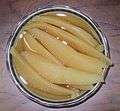 |
Japan | Called Kazunoko (数の子). Usually, it is served as a part of Osechi in the Japanese new year. |
| Herring spawn | 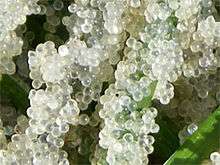 |
Japan | Called Komochi-Kombu (子持昆布). Usually, it is served as a part of Sushi or Chinmi. |
| Herring noodle | Japan | Called Nishin-soba (にしん蕎麦). Hokkaido]. | |
| Herring spawn | 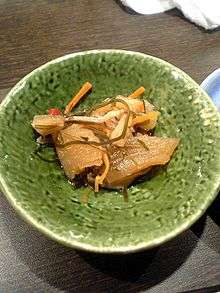 |
Japan | Called matsumae-duke(松前漬け). Hokkaido]. |
| Herring soup | Sweden | ||
| Kibinago | 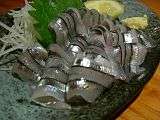 |
Japan | |
| Kipper | United Kingdom | A whole herring that has been split from tail to head, gutted, salted or pickled, and cold smoked. | |
| Pickled herring | 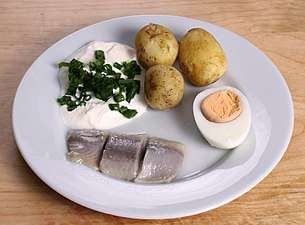 |
||
| Shmaltz herring | |||
| Solomon Gundy | 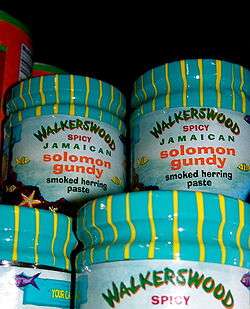 |
Jamaica | |
| Soused herring |  |
Netherlands | |
| Surströmming | 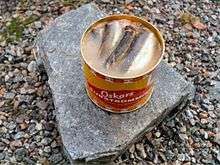 |
Sweden | |
| Rollmops | 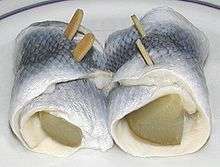 |
||
| Vorschmack | 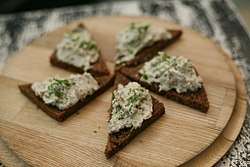 |
Ashkenazi Jews (Eastern Europe) | Chopped herring salad |
 Bloaters on yellow paper, van Gogh, 1889
Bloaters on yellow paper, van Gogh, 1889 Smoked herring
Smoked herring- Traditional Finnish herring stew
Notes
- Cushing, David H (1975) Marine ecology and fisheries Cambridge University Press. ISBN 9780521099110.
- Went, AEJ (1972) "The History of the International Council for the Exploration of the Sea". Proceedings of the Royal Society of Edinburgh. Section B. Biology, 73: 351–360.doi:10.1017/S0080455X0000240X
- Pauly, Daniel (2004) Darwin's Fishes: An Encyclopedia of Ichthyology, Ecology, and Evolution Page 109, Cambridge University Press. ISBN 9780521827775.
- "What's an oily fish?". Food Standards Agency. 2004-06-24.
- "Omega-3 fatty acids: The power of fish". Cleveland Clinic. 2 January 2019. Retrieved 17 June 2019.
- "Toxics in the Food Web: Pacific Herring and Harbor Seals". US Environmental Protection Agency. 7 August 2018. Retrieved 17 June 2019.
- "Mercury Levels in Commercial Fish and Shellfish (1990-2012)". US Food and Drug Administration. 25 October 2017. Retrieved 17 June 2019.
- Mansooreh Jami, Mahdi Ghanbari, Marija Zunabovic, Konrad J. Domig, Wolfgang Kneifel (2014). "Listeria monocytogenes in Aquatic Food Products—A Review". Comprehensive Reviews in Food Science and Food Safety. 13 (5): 798–813. doi:10.1111/1541-4337.12092.CS1 maint: uses authors parameter (link)
- "Herring egg harvest re-opens with health advice to reduce the risk of illness". Island Health, Ministry of Health, Government of British Columbia, Canada. 28 February 2019. Retrieved 17 June 2019.
- Zukin N and Zusman M (2013) The Artisan Jewish Deli at Home page 122, Andrews McMeel Publishing. ISBN 9781449441326.
- Pescaviar product page for Avruga Archived 2012-06-25 at the Wayback Machine
- Mason, Laura (2004). Food Culture in Great Britain. Greenwood Publishing Group. p. 80.
- Fearnley-Whittingstall, Hugh; Fisher, Nick (2007). The River Cottage Fish Book. Bloomsbury. p. 168.
- Bender, David A. (2007). A Dictionary of Food and Nutrition. Oxford University Press. p. 256.
- "Isle of Man: Nature: Get Kippered". BBC. 27 April 2008. Retrieved 30 March 2011.
- Partridge, Eric (1983). Origins: a short etymological dictionary of modern English (1983 ed.). New York: Greenwich House. p. 50. ISBN 0-517-41425-2.
- Organisation for Economic Co-Operation and Development (2009) Multilingual Dictionary of Fish and Fish Products Page 147, John Wiley & Sons. ISBN 9781405157605.
- Food Chemistry, Springer, 27 February 2009, ISBN 9783540699330, retrieved 30 March 2011
- "Buckling". Archived from the original on 6 July 2011. Retrieved 30 March 2011.
- Herring under a fur coat
- in the U.S.S.R., by Anya von Bremzen in Food&Wine, Published: December 2003
- New Year Celebration History (in Russian)
- Herring under a fur coat Archived 2012-02-24 at the Wayback Machine recipe with an apple
References
- Froese, Rainer and Pauly, Daniel, eds. (2006). Species of Clupea in FishBase. January 2006 version.
- O'Clair, Rita M. and O'Clair, Charles E., "Pacific herring," Southeast Alaska's Rocky Shores: Animals. pg. 343-346. Plant Press: Auke Bay, Alaska (1998). ISBN 0-9664245-0-6
External links
| Wikibooks Cookbook has a recipe/module on |
- Nutrition Facts for Herring
- In praise of the humble herring The Independent, 1 September 2005.
- En route: Scandinavia; Herring, the Fish That Roared New York Times, 30 October 2002.
